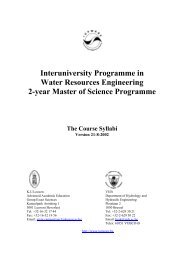CFHT operating manual - Homepage Usask
CFHT operating manual - Homepage Usask
CFHT operating manual - Homepage Usask
Create successful ePaper yourself
Turn your PDF publications into a flip-book with our unique Google optimized e-Paper software.
ESPaDOnS: instrument details and configurations http://webast.ast.obs-mip.fr/magnetisme/espadons_new/configs.html<br />
Instrument configurations<br />
To keep ESPaDOnS as simple as possible, it has been designed as a ’point and shoot’ instrument with very few different<br />
configurations. Only three choices are available:<br />
a spectropolarimetric mode in which the two orthogonal states of a given polarisation - either circular (Stokes V) or<br />
linear (Stokes Q or U) - are recorded throughout the whole spectral range; the two spectra are recorded simultaneously<br />
on the ccd detector with the two sets of orders interleaved; the two fibre images are sliced in 3 at spectrograph entrance,<br />
yielding an average spectral resolution of about 68,000;<br />
a first spectroscopic mode (called ’object+sky’) in which the spectra of the star and of the background sky are<br />
recorded simultaneously on the ccd detector (with orders interleaved); again, the two fibre images are sliced in 3 at<br />
spectrograph entrance, and the average spectral resolution is about 68,000;<br />
a second spectroscopic mode (called ’object only’) in which we only collect the spectrum from the star and neglect<br />
that from the background sky (for objects bright enough to outshine the sky background); in this case, the single fibre<br />
image is sliced in 6 at spectrograph entrance, bringing the average spectral resolution to about 81,000.<br />
© Jean-François Donati, last update May 18 2004<br />
3 of 3 08/07/04 11:28 PM

















